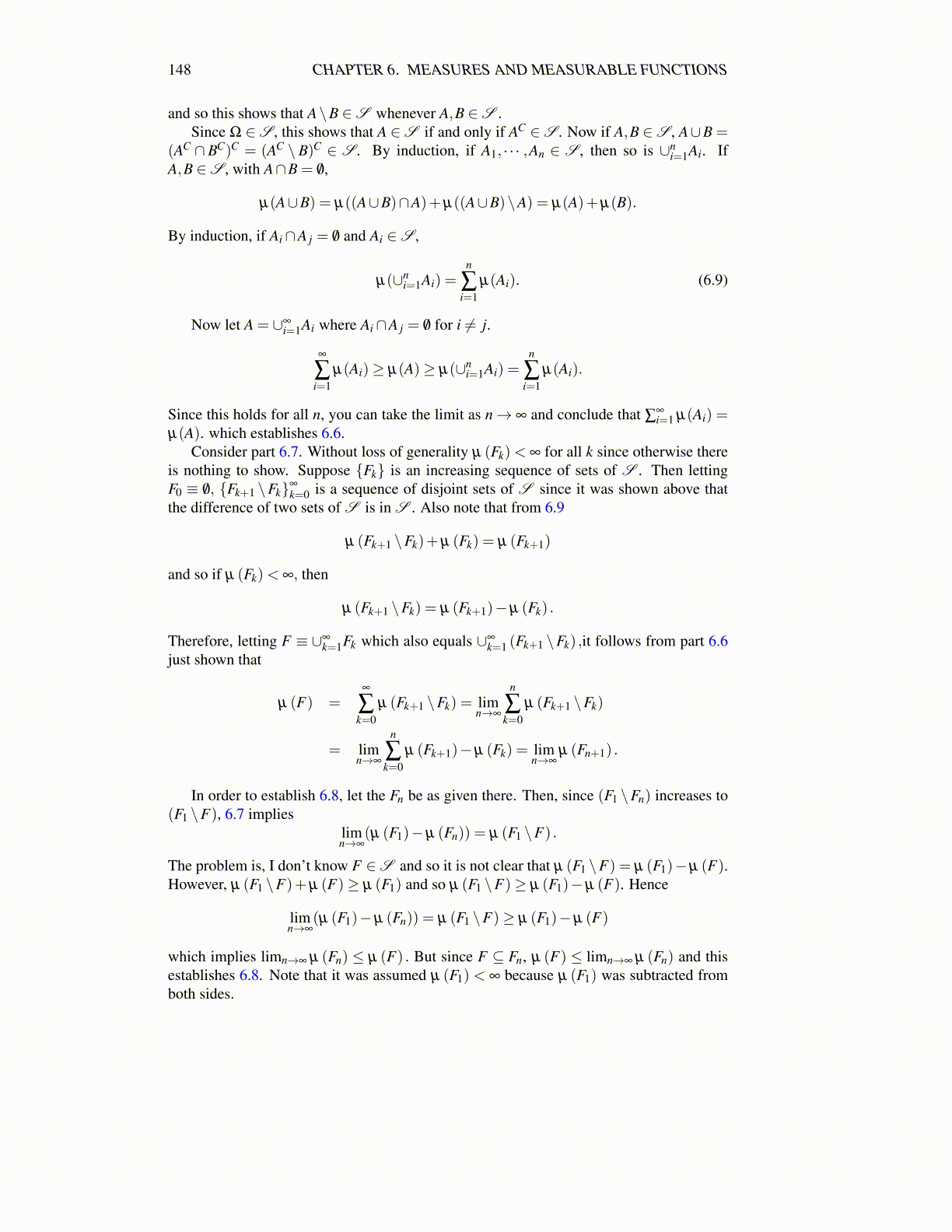
148 CHAPTER 6. MEASURES AND MEASURABLE FUNCTIONS
and so this shows that A\B ∈S whenever A,B ∈S .Since Ω ∈S , this shows that A ∈S if and only if AC ∈S . Now if A,B ∈S , A∪B =
(AC ∩ BC)C = (AC \ B)C ∈ S . By induction, if A1, · · · ,An ∈ S , then so is ∪ni=1Ai. If
A,B ∈S , with A∩B = /0,
µ(A∪B) = µ((A∪B)∩A)+µ((A∪B)\A) = µ(A)+µ(B).
By induction, if Ai∩A j = /0 and Ai ∈S ,
µ(∪ni=1Ai) =
n
∑i=1
µ(Ai). (6.9)
Now let A = ∪∞i=1Ai where Ai∩A j = /0 for i ̸= j.
∞
∑i=1
µ(Ai)≥ µ(A)≥ µ(∪ni=1Ai) =
n
∑i=1
µ(Ai).
Since this holds for all n, you can take the limit as n→ ∞ and conclude that ∑∞i=1 µ(Ai) =
µ(A). which establishes 6.6.Consider part 6.7. Without loss of generality µ (Fk)< ∞ for all k since otherwise there
is nothing to show. Suppose {Fk} is an increasing sequence of sets of S . Then lettingF0 ≡ /0, {Fk+1 \Fk}∞
k=0 is a sequence of disjoint sets of S since it was shown above thatthe difference of two sets of S is in S . Also note that from 6.9
µ (Fk+1 \Fk)+µ (Fk) = µ (Fk+1)
and so if µ (Fk)< ∞, then
µ (Fk+1 \Fk) = µ (Fk+1)−µ (Fk) .
Therefore, letting F ≡ ∪∞k=1Fk which also equals ∪∞
k=1 (Fk+1 \Fk) ,it follows from part 6.6just shown that
µ (F) =∞
∑k=0
µ (Fk+1 \Fk) = limn→∞
n
∑k=0
µ (Fk+1 \Fk)
= limn→∞
n
∑k=0
µ (Fk+1)−µ (Fk) = limn→∞
µ (Fn+1) .
In order to establish 6.8, let the Fn be as given there. Then, since (F1 \Fn) increases to(F1 \F), 6.7 implies
limn→∞
(µ (F1)−µ (Fn)) = µ (F1 \F) .
The problem is, I don’t know F ∈S and so it is not clear that µ (F1 \F) = µ (F1)−µ (F).However, µ (F1 \F)+µ (F)≥ µ (F1) and so µ (F1 \F)≥ µ (F1)−µ (F). Hence
limn→∞
(µ (F1)−µ (Fn)) = µ (F1 \F)≥ µ (F1)−µ (F)
which implies limn→∞ µ (Fn) ≤ µ (F) . But since F ⊆ Fn, µ (F) ≤ limn→∞ µ (Fn) and thisestablishes 6.8. Note that it was assumed µ (F1) < ∞ because µ (F1) was subtracted fromboth sides.